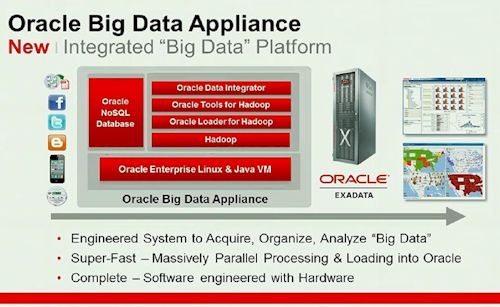This article is more than 1 year old
The firm that swallowed the Sun: Is Oracle happy as Larry with hardware and systems?
One swallow didn't make a summer
Oracle vs IBM
Exadata was the first, being of 2009 vintage, featuring database and storage servers, and then using HP hardware. Subsequent versions from v2 in 2010 used Sun X86 server and storage hardware with flash memory caching for server speed, and an internal InfiniBand network for data transfer speed between servers and storage.

Oracle Big Data Appliance
Oracle boss Larry Ellison promised to pay $10m to any US Fortune 1000 business, demonstrating that the Exadata system didn’t run at least twice as fast as any IBM system running the Oracle database.
Exadata is continuously being developed, with V5 announced in January 21.
The SuperCluster is Oracle’s fastest engineered system of all. A T5 version of this was launched in June 2013. It has two T5-8 server nodes, eight meaning eight sockets, and came in half-rack and full rack configs. The half rack had four CPUs per node and four Exadata storage servers. The full rack sibling gets eight CPUs per node and eight storage servers.
We can expect a T6 version later this year.
The Big Data Appliance, using Exadata clusters and Cloudera software, came out in October 2011
IBM fired back – did it score a hit?
Three years after Oracle introduced its Engineered Systems, IBM responded with its PureSystems. These were based on Power7 and also Intel Xeon processors with external Fibre Channel-connected Storwize V7000 storage arrays – so not very integrated really.
The OS environment was a jumble: Windows Server, Red Hat or SUSE Linux on Intel and AIX, IBM i, Red Hat and SUSE Linux on Power.
IBM called it a scale-in design because it integrated server, storage and networking. There were PureFlex infrastructure clouds, PureApplications application servers and PureData analytics appliances. Towards the end of 2012 it claimed 1,000 customers for these PureSystems. A year or so later, in October 2013, it said it had shipped more than 6,000 of them, and is now saying it has shipped more than 10,000.
Soon additional variants included the PureFlex Solution for SmartCloud Desktop Infrastructure (VDI), PureData System for Analytics (using Netezza) and a PureData System for Hadoop. Now IBM has three basic versions: PureFlex System for infrastructure, PureApplication System for or transactional web and database applications and PureData System for delivering big data services.
Of course the X86 server components now come from Lenovo.
Oracle believes its more tightly integrated engineered systems delivered more bangs per buck. It also says its software is better value for money; IBM doesn't let its customers reuse or migrate existing licences of WebSphere Application Server or DB2 to the PureApplication System. Also, IBM applications have to be bundled in a virtualised pattern, for which the firm charges extra. Oracle says it provides its templates at no additional cost.
So... where are we?
Compared to Dell, HP and IBM, Oracle has done a great job of growing its overall business and using its hardware assets to do this. Dell has had to go private to restructure its products and organisation. HP is splitting into two separate businesses and IBM has sold off its server business to Lenovo.
Cisco has grown its X86 server business but has no storage business worth much at all, basically using partnerships to provide storage to its customers.
Dell, HP, HDS and IBM are either late or nowhere in converged systems while Cisco is, once again, relying on partnerships. It is not too much of a stretch to argue that Oracle reigns supreme in converged systems and that its proprietary CPU business, SPARC, is far from being a weak competitor to X86. In fact, like PowerPC, it has enough momentum on its own, you could argue, for it to survive and prosper against X86, having seen off the weakling HP/Intel Itanium product.
Intel prefers to have its processors ganged together rather than build bigger ones and that provides space for SPARC and PowerPC architectures.
Where Oracle is weak is in supplying public cloud providers and web-scale app service suppliers such as Amazon, Facebook and Google. So long as substantial hybrid cloud enterprise computing exists then Oracle has a market to play in and there is no single supplier that threatens its hardware business with anything other than respectable competition.
It’s a great, great company, and a substantial part of its current business is attributable to the hardware it has, hardware that was bought in 2010 and will be seen as a far-sighted and shrewd purchase. Happy anniversary, Larry. ®
